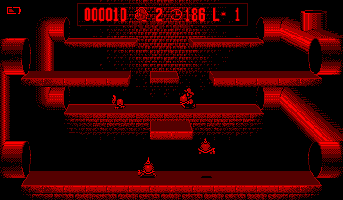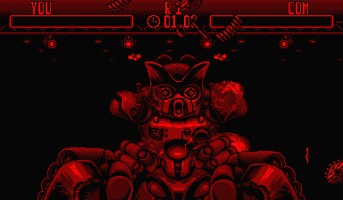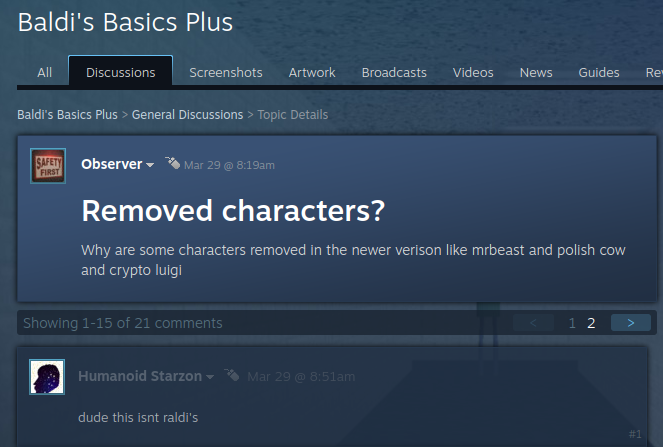- Joined
- Jan 3, 2008
- Messages
- 10,579
- Trophies
- 2
- Age
- 48
- Location
- From Where???
- Website
- wiki.gbatemp.net
- XP
- 5,535
- Country

<font color="red">GBAtemp.net review of the...</font>
<font size="5"><font color="#000080">Virtual Boy</font></font>

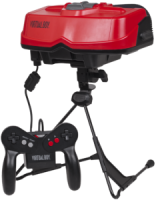
Manufactured by: Nintendo
Also Known As: VB
Review by Another World - completed 1/30/2012
Review Contents & Index:
Historians tell us that Euclid laid out the principles of "3D" with the discovery that the left and right eye view the same image differently, and thus perception of depth can be achieved by merging two images of the same subject matter. These images, known as stereoscopic photographs, were eventually perfected as a form of entertainment in the late 1800s through the use of a stereoscope.
Since the creation of the 3-dimensional image, the entertainment legitimacy of the genre has been hampered by poor execution. Where the stereoscope prevailed, perhaps due to a simpler time when such things amazed, the 3D comic book and print industry, video game industry, and movie industry (just to mention a few) have not. Instead of being embraced as an additional tool for entertainment, the inclusion of 3D was often tacked on as an afterthought and viewed as a gimmick for boosting sales.
When the Virtual Boy was first conceptualized the idea was not to "wow" the consumer with non-immersive gimmick filled 3D software, but to provide a unique experience that pulled the user deeper into the world of the third dimension. For the first time since the stereoscope, an attempt was being made to reestablish the commonality of 3D entertainment.
<div class="reviewbreak"><a name="b"></a>Virtual Boy Design and Acceptance</div><br>
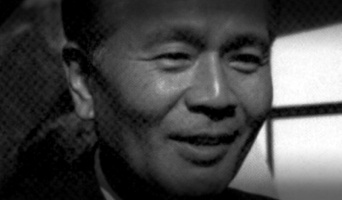
Many gaming and technology publications over the years have poignantly expressed the unattractive elements of the Virtual Boy while missing the genius that was its design. Gunpei Yokoi's unique vision included a desire to immerse the player in a coordinated site and sound experience. He envisioned a way to completely block obtrusive outside light sources, resulting in a graphical experience that would contain boundaries difficult to sense. Carefully positioned stereo speakers and an optional ear phone jack aided his design by engulfing the user into a 2nd immersive layer. Once mounted, positioned, and adjusted, the Virtual Boy would stand complete. Moving one's senses into the 3D gaming experience one would quickly understand Yokoi's vision. For this is the way games should be played, free from all outside disturbances and allowing the user an opportunity to escape the influences of reality.
The core fundamentals which propelled the conceptual idea that was the Virtual Boy initially existed only in its creator's imagination. Following much experimentation, it was clear to Yokoi that some technology for manifesting his vision did not yet exist. One such impossibility was the inclusion of a full color display. The Virtual Boy's graphical effects are produced through the use of curved oscillating mirrors which rapidly scan 1x224 linear arrays across the user's eyes. The oscillating mirrors make it possible to transform a 1-dimentional line of pixels into a 2-dimentional field of pixels. For this effect to function correctly a certain level of brightness was required. Red was the only high-efficient LED color available at the time which was capable of producing the desired level of brightness, resulting in the iconic red-and-black graphical scheme which has always set the VB apart.
In the mid-90's, Nintendo consoles were being classified as "everyday entertainment." During this movement a vast majority of Nintendo supporters accepted the VB as a new console. Interpreted by gamers as a successor to the Gameboy, the VB was fully marketed by Nintendo as a licensed product instead of a niche system. Many critics viewed the Virtual Boy's RISC-based 32-bit core as limited by the red colored graphics and its use of wire-frame effects. The unattractiveness of wire-frame effects eventually forced many game designers to embrace layered 2D graphics which were scaled for psudo-3D. This became a complicated issue as the appeal of the system was its ability to render 3D wire-frame effects yet such effects would surely limited which type of games could be produced. As a result, Nintendo had a hard time marketing the system while consumers had an even more difficult time accepting it for the console it was being marketed as.
Once classified as a console, the Virtual Boy struggled to sell while reviewers from around the globe attacked it for what they viewed as obvious flaws. The VB was dubbed the "eye burner" and often written about as causing headaches, while the mounted design of the unit was described as causing neck and back injury. Many reviewers also found the dual d-pad 6 button controller cumbersome and confusing. Looking over old reviews it is obvious that they were written while viewing the VB in the same light it had been marketed in, when in actuality it was a system designed for occasional conversation inspiring experiences.
The incorrect classification of the system, resulting in a misinterpretation of consumer gaming expectations, can not be fully blamed for the failure of the Virtual Boy. A system is only as good as its software and the Virtual Boy's generation-1 software release lineup was not exactly ground breaking. While the games showed off the positives of wire-frame and psudo-3D effects, most played like tech-demos. Only a few titles competed with the epic platforming adventures, complex logical puzzles, and immersive experiences which had already been released on the NES, Gameboy, SNES, and soon to be released for the N64. In comparison, the VB's 22 game library included mostly quick pick-up-and-play arcade experiences, a concept which worked perfectly for the "niche Virtual Boy system" but not so much for the "Gameboy-successor Virtual Boy system".
Many Web sites have collected and published listings for unreleased and discontinued Virtual Boy software, and after reading such publications it is easy to speculate that the 2nd generation of software may have saved the system. It is unfortunate that both Nintendo and its consumers gave up on the system before it was able to reach its full potential. Sadly, the Virtual Boy was discontinued less than a year after its release, having sold only 770,000 units worldwide.
<div class="reviewbreak"><a name="c"></a>Technical Specifications</div><br>Processor:
The Virtual Boy used for this review was purchased from a popular Internet auction site. It may be missing some of the packaging contents and therefore it is suggested that the listing below be used for reference only. The images of the packaging and the unit inside of the packaging are not my own. While the review unit did ship in its original box, the packaging and its contents have been packed away and were not accessible for this review.
Contents:
<div class="reviewbreak"><a name="e"></a>Design and Impressions</div><Br>
 The Virtual Boy begins at the eyeshade, which is made from a soft black foam-composite material, pre-molded for the shape of the VB. The eyeshade securely clips onto rounded plastic mounts via small pre-cut holes. The eyeshade fulfills a design idea of Gunpei Yokoi by blocking outside light interferences, but is not required to use the system. The same experience can be had by playing the Virtual Boy in a completely dark room, while only missing out on the small bit of comfort the eyeshade provides for a resting forehead. The eyeshade is often missing from used VB units and a new piece may sell between $20-40 at auction. A good question to consider asking before buying an eyeshade is if it is ripped, torn, or sweat stained in any way.<br><br>
The Virtual Boy begins at the eyeshade, which is made from a soft black foam-composite material, pre-molded for the shape of the VB. The eyeshade securely clips onto rounded plastic mounts via small pre-cut holes. The eyeshade fulfills a design idea of Gunpei Yokoi by blocking outside light interferences, but is not required to use the system. The same experience can be had by playing the Virtual Boy in a completely dark room, while only missing out on the small bit of comfort the eyeshade provides for a resting forehead. The eyeshade is often missing from used VB units and a new piece may sell between $20-40 at auction. A good question to consider asking before buying an eyeshade is if it is ripped, torn, or sweat stained in any way.<br><br>
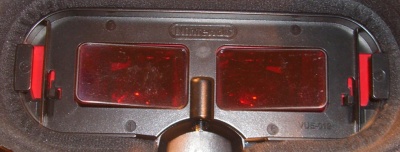 Encased in the VB shell, just behind the eyeshade, are red plastic lenses. The lenses help to protect the interior of the unit from dust while completing the unit's ocular design. The lenses are not critical to the functionality of the unit or its 3D effect. The lenses actually force the unit to have a viewable sweet spot, although not as drastic as some might be thinking. As the positioning of the eye is physically shifted, the extreme top or bottom of the viewable area may appear squished or flattened, just as the sides may appear slightly out-of-focus. Due to this phenomenon some users have removed the lenses all together while others have discussed the possibility of custom glass replacements. The plastic surface of the lenses may be scratched due to improper cleaning or age, it is recommended to inquire about scratches before purchasing a used Virtual Boy unit.<br><br>
Encased in the VB shell, just behind the eyeshade, are red plastic lenses. The lenses help to protect the interior of the unit from dust while completing the unit's ocular design. The lenses are not critical to the functionality of the unit or its 3D effect. The lenses actually force the unit to have a viewable sweet spot, although not as drastic as some might be thinking. As the positioning of the eye is physically shifted, the extreme top or bottom of the viewable area may appear squished or flattened, just as the sides may appear slightly out-of-focus. Due to this phenomenon some users have removed the lenses all together while others have discussed the possibility of custom glass replacements. The plastic surface of the lenses may be scratched due to improper cleaning or age, it is recommended to inquire about scratches before purchasing a used Virtual Boy unit.<br><br>
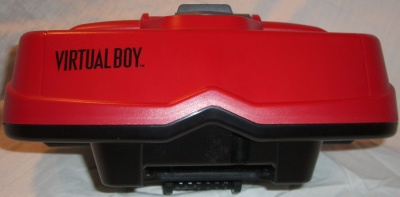
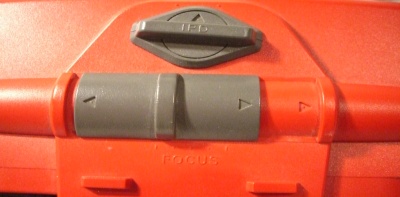 The core electronics of the Virtual Boy are surrounded by a shiny red and black plastic shell. The shell is curvy and embraces a futuristic design that is both classic and retro. On the top of the shell are a gray slider switch and a gray knob. The slider adjusts the graphical focus level, and the circular knob, known as the Inter-Pupil Distance knob, adjusts the left and right display distances. The more the IPD knob is turned, the closer the graphics will appear to the eye on that side. For those with strong corrective lenses, there really is not a 100% perfect set-up between the focus level, IPD adjustment, and red plastic lenses. The ideal situation for some is to make the graphics as even as possible, with a focus level that is comfortable to view for long periods.
The core electronics of the Virtual Boy are surrounded by a shiny red and black plastic shell. The shell is curvy and embraces a futuristic design that is both classic and retro. On the top of the shell are a gray slider switch and a gray knob. The slider adjusts the graphical focus level, and the circular knob, known as the Inter-Pupil Distance knob, adjusts the left and right display distances. The more the IPD knob is turned, the closer the graphics will appear to the eye on that side. For those with strong corrective lenses, there really is not a 100% perfect set-up between the focus level, IPD adjustment, and red plastic lenses. The ideal situation for some is to make the graphics as even as possible, with a focus level that is comfortable to view for long periods.
On the top of the shell and just behind the focus slider are two small raised plastic ridges. These ridges are used for holding the cartridge dust cover, which is snapped into place. The game cartridge itself is inserted label-side-up into the front of the unit. The cartridge slot, which is on the front underside of the shell, does not have any type of dust protection. Most users choose to keep a cartridge in their VB to protect the contacts from dust and debris, while others choose to blow out the slot with a can of compressed air prior to each use.<br><br>

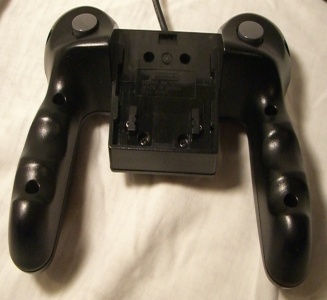 The controller consists of 2 directional pads, 6 buttons (2 per d-pad, 2 trigger buttons), and 2 grips. The battery compartment (or optional AC adaptor) slides onto the back of the controller and clicks into place. When attached, it appears a bit cumbersome but does not get in the way while playing, due to the excellent positioning of the controllers various buttons in relation to the hand grips. The cord which comes out of the top of the controller plugs into the underside of the shell, and not only provides a route for input signals but also powers the unit. When gripped, the smooth black shell of the controller is very comfortable. The contoured grips feel well positioned and are the perfect thickness for hands of all sizes.<br><br>
The controller consists of 2 directional pads, 6 buttons (2 per d-pad, 2 trigger buttons), and 2 grips. The battery compartment (or optional AC adaptor) slides onto the back of the controller and clicks into place. When attached, it appears a bit cumbersome but does not get in the way while playing, due to the excellent positioning of the controllers various buttons in relation to the hand grips. The cord which comes out of the top of the controller plugs into the underside of the shell, and not only provides a route for input signals but also powers the unit. When gripped, the smooth black shell of the controller is very comfortable. The contoured grips feel well positioned and are the perfect thickness for hands of all sizes.<br><br>
 On the bottom of the unit are a volume adjustment wheel and a stereo headphone jack. The stereo speakers are located on either side of the unit, just behind embossed rubber Nintendo logos. The speakers rest in a perfect position which helps to direct the sound towards the player's ears. The volume adjustment wheel spins smoothly and is easily accessible while playing. The stereo speaker jack is far enough out of the way that using ear buds will not interfere with volume adjustments when gaming.<br><br>
On the bottom of the unit are a volume adjustment wheel and a stereo headphone jack. The stereo speakers are located on either side of the unit, just behind embossed rubber Nintendo logos. The speakers rest in a perfect position which helps to direct the sound towards the player's ears. The volume adjustment wheel spins smoothly and is easily accessible while playing. The stereo speaker jack is far enough out of the way that using ear buds will not interfere with volume adjustments when gaming.<br><br>
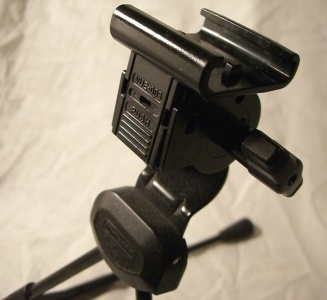 The final and most important component to the Virtual Boy's design is the metal stand. The stand unfolds by pulling either leg outwards and away from the center pivot point. Once fully extended the stand clips onto the underside of the VB unit. The stand contains a clamp release button on the front and a swivel knob on the side. The swivel knob is an integral part of enjoyment as it dictates the level of comfort. Depending on how tall the user is, or the height of their desk/table, the unit can be swiveled forward allowing the user to find their most comfortable playing position. Unfortunately, as integral to the experience as the stand is, it is also the weakest point. The plastic center of the stand often cracks due to age or from aggressive unfolding. Once the plastic fully cracks it may no longer support the weight of the Virtual Boy. Due to this problem, complete stands often sell on the Internet for upwards of $50. It is advisable to inquire about the condition of the stand before making a purchase, as this single item can dictate an entire level of enjoyment. However, if the stand arrives in an unusable condition, solutions do exist. One PlanetVB member developed a replacement part using manufacturing grade tools. Other users have cannibalized the mount and replaced the stand with various clamps and custom creations. Of course, the low budget solution is to position the Virtual Boy on top of a stack of books or a cardboard box.
The final and most important component to the Virtual Boy's design is the metal stand. The stand unfolds by pulling either leg outwards and away from the center pivot point. Once fully extended the stand clips onto the underside of the VB unit. The stand contains a clamp release button on the front and a swivel knob on the side. The swivel knob is an integral part of enjoyment as it dictates the level of comfort. Depending on how tall the user is, or the height of their desk/table, the unit can be swiveled forward allowing the user to find their most comfortable playing position. Unfortunately, as integral to the experience as the stand is, it is also the weakest point. The plastic center of the stand often cracks due to age or from aggressive unfolding. Once the plastic fully cracks it may no longer support the weight of the Virtual Boy. Due to this problem, complete stands often sell on the Internet for upwards of $50. It is advisable to inquire about the condition of the stand before making a purchase, as this single item can dictate an entire level of enjoyment. However, if the stand arrives in an unusable condition, solutions do exist. One PlanetVB member developed a replacement part using manufacturing grade tools. Other users have cannibalized the mount and replaced the stand with various clamps and custom creations. Of course, the low budget solution is to position the Virtual Boy on top of a stack of books or a cardboard box.
<div class="reviewbreak"><a name="f"></a>Set-up and Usage</div><br>
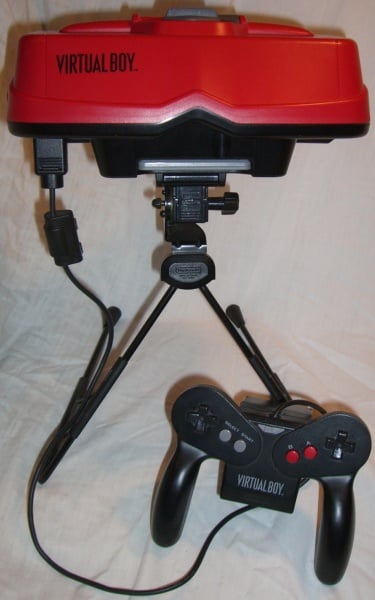 If the eyeshade is not already mounted it can be quickly positioned by placing the pre-cut holes over the rounded plastic stubs. The stand should be pulled outwards slowly until it is fully extended and placed with the rubber feet pointing away from the user. The stand can be placed in either direction but supports a downward positioned VB much more securely if the feet point away from the user. The Virtual Boy is placed into the stand by lining up the front of the clasp and then snapping it into place by rocking it backwards towards the user. Once mounted, the VB can be adjusted for the perfect position using the swivel knob. The battery pack (or optional AC adaptor) is clicked onto the back of the controller and then the controller is plugged into the bottom of the unit. Finally, the game cartridge is inserted, label-side-up, into the cartridge slot located on the front underside of the unit.
If the eyeshade is not already mounted it can be quickly positioned by placing the pre-cut holes over the rounded plastic stubs. The stand should be pulled outwards slowly until it is fully extended and placed with the rubber feet pointing away from the user. The stand can be placed in either direction but supports a downward positioned VB much more securely if the feet point away from the user. The Virtual Boy is placed into the stand by lining up the front of the clasp and then snapping it into place by rocking it backwards towards the user. Once mounted, the VB can be adjusted for the perfect position using the swivel knob. The battery pack (or optional AC adaptor) is clicked onto the back of the controller and then the controller is plugged into the bottom of the unit. Finally, the game cartridge is inserted, label-side-up, into the cartridge slot located on the front underside of the unit.
The Virtual Boy is powered on by sliding a small switch on the face of the controller to the right. The switch does not contain any indication lights and the only way to be sure the switch is in the "on" position is by the visibility of a reddish-orange sticker. Once the unit powers-up a warning is displayed, which instructs the user to read the instruction booklet. Following this screen is the main logo splash screen. In each of the 4 corners of this main screen are tiny “VB” logos, which are the main positioning points for the IPD circular knob. It is near impossible to perfectly adjust the logos so that each is at the exact same depth, but the goal is to make all 4 logos as visible as possible. The focus slider can be adjusted at this point as well but it is best left until a game starts. Once the IPD is in position, a game can be launched by pressing one of the controller buttons, and which button to press may depend on the game/Homebrew being played.
The ideal gaming position is to have the Virtual Boy mounted on a mid-level desktop and pointed slightly downwards. This will allow the user to sit forward in a more natural position with their hands out in front of the stand. It is possible to play with the controller behind the unit but it is much more comfortable to have one's arms resting on the desktop with the controller in front of the unit.
<div class="reviewbreak"><a name="g"></a>Virtual Boy Retail Games</div>
The Virtual Boy and N64 were being developed at the same time, and it was clear that Nintendo wanted to focus on one system. They pushed for the release of the Virtual Boy perhaps before it was ready, marketed it as a complete console, and were unable to convince the public of its $180 worth. The Virtual Boy was on the market for less than a year and the version we enjoy today is actually considered a prototype for what Nintendo had wanted to develop.
The short and abrupt shelf life caused many promising games to get scrapped. The retail release listing of Virtual Boy games is only 22 units, 19 of which were released to Japan and 14 of which were released to North America.
A listing of the complete Virtual Boy retail library:
Red Alarm is a space shooting game that shows off the wireframe effects of the Virtual Boy. Teleroboxer demonstrates the 3D effects of the system through the perspective of a 1st person robot boxing game. Panic Bomber has a wonderfully short 3D introduction and Virtual Boy Wario Land has an excellent 3D title screen. However, as this review is for the Virtual Boy system itself no single games will be reviewed or recommended. Instead a word of caution, some feel that not all of the titles are worth playing but all VB owners agree that all titles are worth experiencing on actual hardware. Before buying any games, do a little bit of research and see if it is worth the asking prince. Most games can be purchased for under $30 with a box, while others can be purchased for under $10 without the box or instruction booklet.
<div class="reviewbreak"><a name="h"></a>The Virtual Boy's Flaw</div><br>
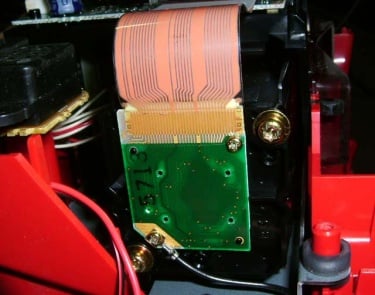 The two ribbon cables which connect the visual units to the motherboard trade signals across a glued connection point. For some unknown reason Nintendo chose to go this route instead of solder or male-to-female connection ends. The glue inevitability degrades with age and usage, no matter how careful you are with your electronic toys or the IPD knob. Many users complain about a common set of issues which are all directly related to the glue degrading. The list of issues includes dimmed backlighting, scanlines, glitchy graphics, blank screens, or solid red screens.
The two ribbon cables which connect the visual units to the motherboard trade signals across a glued connection point. For some unknown reason Nintendo chose to go this route instead of solder or male-to-female connection ends. The glue inevitability degrades with age and usage, no matter how careful you are with your electronic toys or the IPD knob. Many users complain about a common set of issues which are all directly related to the glue degrading. The list of issues includes dimmed backlighting, scanlines, glitchy graphics, blank screens, or solid red screens.
There exist three commonly used methods for repairing this problem. The first of which is to remove the cables and to bake them in an oven (or use a heat gun) to help reapply the glue. This method is the most practiced but is never a permanent fix. A less common method is to find something to apply pressure to the cables. Some users have reported positive results with a small piece of wood, a piece of rubber, or even some common household tape. The only permanent fix for this problem is the one that requires the most skill, soldering. The copper coating of the cables must be removed (either through chemicals or during the soldering process) and then the cable can be permanently reattached using a thin line of solder.
Opening the Virtual Boy for repair requires a gamebit, essentially a reversed torque bit that has a female end instead of a male. The problem with the Virtual Boy is that the screws are so deep that common bits will not reach them. Many users will buy a bit and make a small cut deep enough to accept a standard screwdriver. Some users have reported finding a screwdriver/bit combo that is long enough to reach but requires the plastic entry slot of the Virtual Boy to be permanently widened. While other user will use a filing tool to cut a chunk of metal out of the center of a standard screwdriver, allowing for that screwdriver to grip the game-screw on two sides.
There exists a few wonderful guides for making the ribbon repair but most users are not comfortable with attempting this permanent fix. It is rather difficult to find someone who can make the permanent repair, making this flaw a serious issue that needed to be discussed.
<p>Repair Guides by DogP:
 ProjectVB Repair Guide
ProjectVB Repair Guide
 PlanetVB Repair Guide
PlanetVB Repair Guide
</p>
<div class="reviewbreak"><a name="i"></a>Age is a Benefit</div>
Over the past 15 years the Virtual Boy has interested a few talented people who have developed many inspirational projects. Projects range from software to hardware and may hold their existence to the obscurity of the Virtual Boy.
There is a small but thriving Homebrew scene of coders who not only support and help each other, but who have also documented and compiled an extensive coding help file. From these talented coders we now have Virtual Boy coding examples, hardware documentation, and more, all of which are available free of charge. Many coders have proven through existing DEMO projects that there is still life in Virtual Boy development. What has ultimately slowed down what could be one of the most extensive and unique game development opportunities has been the rarity of the system and its Homebrew Flash Kit solutions.
Homebrew enthusiast will be happy to know that thanks to the efforts of an extremely talented hardware engineer, a Virtual Boy Flash Kit does exist. The kits are hand built and cost just around $100 USD. The kit uses an old school approach to Flash Kits, requiring the user to write 1 ROM at a time and only provides 1 battery supported save-bank. There is no way to backup the save file and ROMs must be padded for size before being written. While modern day Flash Kit users may find fault with this design, retro gamers seem extremely content to enjoy rare prototype DEMOs and Homebrew on their Virtual Boy hardware.
A second Flash Kit design has recently surfaced which incorporates a microSD card. This kit is in development and current discussions include the inclusion of a shell and a main GUI menu. It is not yet known if this project will continue active development or ever be completed.
There are many Virtual Boy emulators which have been released for a variety of systems. The most popular of which, due to its 100% compatibility, is Mednafen. Those who are interested in emulation will be happy to hear that a VB-to-PC controller adapter kit does exist and requires only a small amount of amateur soldering. Most VB enthusiast will recommend the use of an actual VB controller as its unique design is not comfortably mimicked by common PC controllers.
Gaming historians who want to dive deeper will find that the past 15 years have been entirely kind to the Virtual Boy. A system which has captured the interest of many gamers, yet overlooked by most during its limited production run, has managed to inspire a collection of hundreds of Internet articles. Just a few minutes spent searching the Web will reveal a plethora of valuable information, interviews, reviews, documentation, Internet auctions, and more. For such a rare system it truly has captivated a strong following.
One of the best and most highly regarded sites related to the Virtual Boy is PlanetVB, who's admin, known as KR155E, has collected and posted just about everything possible related to the Virtual Boy. At one time he owned some of the rarest Virtual Boy testing units and continues to maintain an active discussion forum to this day.
<div class="reviewbreak"><a name="j"></a>Conclusion</div>
The Virtual Boy was released upon a gaming public already comfortable with their console choices. It was offered during a time when 3D gaming was simply a game-a-system gimmick, used to raise sales and boost creativity. Genpei Yokoi had hoped to convince Nintendo that their consumers were ready for a complete solution, an entire package built around the perspective of eye-popping 3D wire-frame visuals. Nintendo, who had released Yokoi’s other unique gaming concepts (Ten Billion Barrel puzzle, Ultra Machine, Love Tester), understood his vision throughout the extensive development process. However, instead of waiting for the technological advancements which would have solidified Yokoi’s vision, Nintendo chose to release the Virtual Boy and to focus their attention on the development of the N64 console.
Yokoi, who had spent his career developing unique gaming devices, had followed the success of the Gameboy with a niche system, something Nintendo failed to recognize. The Virtual Boy was given a full marketing campaign, complete with store testing units, posters, TV commercials, advertisements, and more. Many electronic gaming historians agree that this marketing campaign was a mistake. Having been marketed as a complete console, the system lacked many features of currently available consoles, such as color graphics, a 2-player mode via the same screen, and popular 1st party software.
Writing a Virtual Boy review in 1995, one would probably have reached a similar conclusion as others, the Virtual Boy was unique but offered an experience challenging to both consumers and game developers. Society was simply not yet ready for a gaming system that strayed so far from the acceptable boundaries. Nintendo had used every opportunity to remind the public that the Virtual Boy was indeed a console and that it had a place in “everyday entertainment”. Yet its quirky oddness and lack of a strong software lineup made it a difficult sell.
The question we must now ask is if the Virtual Boy is actually worth owning.
The VB obtained for this review was purchased for more than $100. It has minor scratching on the red lenses and suffers from the beginnings of ribbon cable failure. However, these are the only issues, and aesthetically speaking the unit is in otherwise near mint condition. Yet, it may not have been worth the asking price if one determines the value of their gaming systems solely on available software.
Thanks to the invention of the Virtual Boy Flash Kit, each of the 22 retail games and a few rare prototype ROMs have been fully experienced. Homebrew for the system has been discussed, tested, and enjoyed. The 3D effect has been examined for its effectiveness as well as its usefulness in aiding the gaming experience. The conclusion reached is that the system is definitely a treat to own when enjoyed in small increments.
The system itself is not difficult to set-up, and is rather comfortable to play once the position is perfectly dialed in. Where some strongly believe the red graphics were an unfortunate mistake, others find the red-on-black images rather enjoyably soothing. Not all of the 22 retail games are worth owning, but all are an exceptionally unique experience worth playing. Some of the games will steal hours of free time while gamers attempt to break high scores, reach new levels, or simply enjoy the wonderful music and 3D effects. Both the wire-frame and psudo-3D effects have been implemented with perfection. The sense of depth is more apparent than in-your-face 3D imagery, yet foreground popping visuals do exist and never disappoint.
After all of the retail games have been experienced, some more often than others, it becomes clear what is missing. The Virtual Boy is lacking a large Homebrew scene, due in part to the obscurity of the system and the limited pool of interested developers. If there are two things this review hopes to accomplish, one is to express the potential of the Virtual Boy and the other is to inspire developers to code for the system. One can only imagine what it would be to experience Zelda, Mario, Metroid, Donkey Kong, and other 1st party styled titles on the VB. How about a ray-casting engine 1st person shooter such as Doom, overhead arcade-style shooters such as 1942, platformers such as Megaman, or any number of Homebrew projects found on other systems which have the potential to shine as red-and-black 3D gaming concepts.
Those who are willing to shell out the additional $100 USD for a Flash Kit will find that the available Homebrew is fun and the potential to play ROMs on actual hardware is an excellent deciding factor. Those who simply enjoy retail games will find that $200-300 will be enough to purchase a VB and patiently purchase most of its retail software library. Those skillful enough to complete the ribbon cable soldering solution will find that many VB units listed as “broken” sell for under $30.
The VB is a great conversational piece, will excite old and new gamers, and provide hours of entertainment throughout the year. However, those looking for a complete console with hundreds of potential 3D experiences should consider something along the lines of a Nintendo 3DS. The chances of a Virtual Boy Homebrew game development revival are extremely slim, yet for some Homebrew enthusiasts, the chances are enough to merit the purchase of a system. If you love 3D, are nostalgic for old systems, or simply want to try something different, consider purchasing a Virtual Boy. You may just end up finding it the same wonderful experience that this reviewer has!
<font color="green">Pros:</font>
<font color="green">+</font> Excellent build quality
<font color="green">+</font> Unique experience unrivaled by other "retro" systems
<font color="green">+</font> Excellent wire-frame and psudo-3D effects
<font color="green">+</font> A wonderful sound chip that aids the onscreen graphics
<font color="green">+</font> Comfortable controller design, with perfectly positioned buttons
<font color="green">+</font> Optional stereo ear phone jack
<font color="green">+</font> Graphical adjustment knobs which help to perfect the experience
<font color="green">+</font> Interesting Homebrew offerings
<font color="green">+</font> Many pick-up-and-play arcade-like experiences
<font color="green">+</font> Extremely well documented hardware, software, and adverting
<font color="red">Cons:</font>
<font color="red">-</font> Ribbon cable glue issue
<font color="red">-</font> Difficult to find individuals qualified to make repairs
<font color="red">-</font> Only 22 retail games
<font color="red">-</font> Some replacement parts are rather expensive
<font color="red">-</font> Red lenses graphical distortion issues
<div class="reviewbreak">
 </div>
</div>
Links:
Virtual Boy WIKI Article
Gunpei Yokoi WIKI Article
PlanetVB
"Iwata Asks" about the Virtual Boy
This review was written for GBAtemp.net ONLY. The article and some included photos are the property of Another World and published by permission for GBAtemp.net. The photo of Genpei Yokoi was taken from kotaku.com and used without permission. The VB break down photo is the property of IFixIt and used without permission. The VB Box photos and two of the VB game screen shots are the property of PlanetVB, and used without permission. The VB complete box photo is the property of videogameobsession.com, and used without permission. The ribbon cable photo is the property of ProjectVB and used without permission. Research was conducted by contacting other Virtual Boy owners, Homebrew development programmers, the PlanetVB Forums, and by reading various WIKI articles.
Special thanks to Shaunj66, Costello, the #acekard crew, brien, Cheeky, KR155E, Richard Hutchinson, UG, DogP, and RunnerPack. Without all of you this review would not have been possible.
A very special thanks to Genpei Yokoi (1970-1997) for the Virtual Boy!
If you see this review on any other site please let [m]Another World[/m] know via PM.
<font size="5"><font color="#000080">Virtual Boy</font></font>


Manufactured by: Nintendo
Also Known As: VB
Review by Another World - completed 1/30/2012
Review Contents & Index:
- <a style="text-decoration: none;" href="#a">Introduction</a>
- <a style="text-decoration: none;" href="#b">Virtual Boy Design and Acceptance</a>
- <a style="text-decoration: none;" href="#c">Technical Specifications</a>
- <a style="text-decoration: none;" href="#d">Contents and Packaging</a>
- <a style="text-decoration: none;" href="#e">Design and Impressions</a>
- <a style="text-decoration: none;" href="#f">Set-up and Usage</a>
- <a style="text-decoration: none;" href="#g">Virtual Boy Retail Games</a>
- <a style="text-decoration: none;" href="#h">The Virtual Boy's Flaw</a>
- <a style="text-decoration: none;" href="#i">Age is a Benefit</a>
- <a style="text-decoration: none;" href="#j">Conclusion</a>
Historians tell us that Euclid laid out the principles of "3D" with the discovery that the left and right eye view the same image differently, and thus perception of depth can be achieved by merging two images of the same subject matter. These images, known as stereoscopic photographs, were eventually perfected as a form of entertainment in the late 1800s through the use of a stereoscope.
Since the creation of the 3-dimensional image, the entertainment legitimacy of the genre has been hampered by poor execution. Where the stereoscope prevailed, perhaps due to a simpler time when such things amazed, the 3D comic book and print industry, video game industry, and movie industry (just to mention a few) have not. Instead of being embraced as an additional tool for entertainment, the inclusion of 3D was often tacked on as an afterthought and viewed as a gimmick for boosting sales.
When the Virtual Boy was first conceptualized the idea was not to "wow" the consumer with non-immersive gimmick filled 3D software, but to provide a unique experience that pulled the user deeper into the world of the third dimension. For the first time since the stereoscope, an attempt was being made to reestablish the commonality of 3D entertainment.
<div class="reviewbreak"><a name="b"></a>Virtual Boy Design and Acceptance</div><br>

The core fundamentals which propelled the conceptual idea that was the Virtual Boy initially existed only in its creator's imagination. Following much experimentation, it was clear to Yokoi that some technology for manifesting his vision did not yet exist. One such impossibility was the inclusion of a full color display. The Virtual Boy's graphical effects are produced through the use of curved oscillating mirrors which rapidly scan 1x224 linear arrays across the user's eyes. The oscillating mirrors make it possible to transform a 1-dimentional line of pixels into a 2-dimentional field of pixels. For this effect to function correctly a certain level of brightness was required. Red was the only high-efficient LED color available at the time which was capable of producing the desired level of brightness, resulting in the iconic red-and-black graphical scheme which has always set the VB apart.
In the mid-90's, Nintendo consoles were being classified as "everyday entertainment." During this movement a vast majority of Nintendo supporters accepted the VB as a new console. Interpreted by gamers as a successor to the Gameboy, the VB was fully marketed by Nintendo as a licensed product instead of a niche system. Many critics viewed the Virtual Boy's RISC-based 32-bit core as limited by the red colored graphics and its use of wire-frame effects. The unattractiveness of wire-frame effects eventually forced many game designers to embrace layered 2D graphics which were scaled for psudo-3D. This became a complicated issue as the appeal of the system was its ability to render 3D wire-frame effects yet such effects would surely limited which type of games could be produced. As a result, Nintendo had a hard time marketing the system while consumers had an even more difficult time accepting it for the console it was being marketed as.
Once classified as a console, the Virtual Boy struggled to sell while reviewers from around the globe attacked it for what they viewed as obvious flaws. The VB was dubbed the "eye burner" and often written about as causing headaches, while the mounted design of the unit was described as causing neck and back injury. Many reviewers also found the dual d-pad 6 button controller cumbersome and confusing. Looking over old reviews it is obvious that they were written while viewing the VB in the same light it had been marketed in, when in actuality it was a system designed for occasional conversation inspiring experiences.
The incorrect classification of the system, resulting in a misinterpretation of consumer gaming expectations, can not be fully blamed for the failure of the Virtual Boy. A system is only as good as its software and the Virtual Boy's generation-1 software release lineup was not exactly ground breaking. While the games showed off the positives of wire-frame and psudo-3D effects, most played like tech-demos. Only a few titles competed with the epic platforming adventures, complex logical puzzles, and immersive experiences which had already been released on the NES, Gameboy, SNES, and soon to be released for the N64. In comparison, the VB's 22 game library included mostly quick pick-up-and-play arcade experiences, a concept which worked perfectly for the "niche Virtual Boy system" but not so much for the "Gameboy-successor Virtual Boy system".
Many Web sites have collected and published listings for unreleased and discontinued Virtual Boy software, and after reading such publications it is easy to speculate that the 2nd generation of software may have saved the system. It is unfortunate that both Nintendo and its consumers gave up on the system before it was able to reach its full potential. Sadly, the Virtual Boy was discontinued less than a year after its release, having sold only 770,000 units worldwide.
<div class="reviewbreak"><a name="c"></a>Technical Specifications</div><br>Processor:
- NEC V810
- 32-Bit RISC Processor at 20 MHz (18 MIPS) Clock Speed
- 1 MB of DRAM and 512 KB of P-SRAM
- 1 KB Cache
- RTI (Reflection Technology Inc.) SLA dual mirror-scan, high resolution LED displays
- Resolution: 384 x 224 Pixels
- 50.2 Hz Horizontal Scan Rate
- 4 colors with 32 levels of intensity
- 6 AA Batteries (9V) or AC Adapter (10V)
- 16-Bit Stereo
- Build-In Stereo-Speakers
- Double-Grip Controller with 6 Buttons and 2 D-pads
- Uses NES Controller Protocol
- 8 Pin Cable
- Bandwidth 50 - 100 KBit/second
- 760 g
- 8.5 H x 10 W x 4.3 D
- 128 MBit addressable ROM space (4 - 16 MBit ROM used in released games)
- 128 MBit addressable RAM space (0 - 8 KiloByte RAM in released games)
- 128 MBit addressable expansion space (Unused in any games)
- 60-pin connector
- Toshiba "TC538200AFT" and "TC5316200AFT" ROM chips in 16 Bit mode
The Virtual Boy used for this review was purchased from a popular Internet auction site. It may be missing some of the packaging contents and therefore it is suggested that the listing below be used for reference only. The images of the packaging and the unit inside of the packaging are not my own. While the review unit did ship in its original box, the packaging and its contents have been packed away and were not accessible for this review.
Contents:
- 1x Virtual Boy System
- 1x System stand
- 1x Controller
- 1x Battery compartment
- 1x Eyeshade
- 1x Manual
- 1x Information booklet
- 2x Promotional booklets
- 1x Mario Tennis game pack
- 1x Mario Tennis manual
<div class="reviewbreak"><a name="e"></a>Design and Impressions</div><Br>




On the top of the shell and just behind the focus slider are two small raised plastic ridges. These ridges are used for holding the cartridge dust cover, which is snapped into place. The game cartridge itself is inserted label-side-up into the front of the unit. The cartridge slot, which is on the front underside of the shell, does not have any type of dust protection. Most users choose to keep a cartridge in their VB to protect the contacts from dust and debris, while others choose to blow out the slot with a can of compressed air prior to each use.<br><br>




<div class="reviewbreak"><a name="f"></a>Set-up and Usage</div><br>

The Virtual Boy is powered on by sliding a small switch on the face of the controller to the right. The switch does not contain any indication lights and the only way to be sure the switch is in the "on" position is by the visibility of a reddish-orange sticker. Once the unit powers-up a warning is displayed, which instructs the user to read the instruction booklet. Following this screen is the main logo splash screen. In each of the 4 corners of this main screen are tiny “VB” logos, which are the main positioning points for the IPD circular knob. It is near impossible to perfectly adjust the logos so that each is at the exact same depth, but the goal is to make all 4 logos as visible as possible. The focus slider can be adjusted at this point as well but it is best left until a game starts. Once the IPD is in position, a game can be launched by pressing one of the controller buttons, and which button to press may depend on the game/Homebrew being played.
The ideal gaming position is to have the Virtual Boy mounted on a mid-level desktop and pointed slightly downwards. This will allow the user to sit forward in a more natural position with their hands out in front of the stand. It is possible to play with the controller behind the unit but it is much more comfortable to have one's arms resting on the desktop with the controller in front of the unit.
<div class="reviewbreak"><a name="g"></a>Virtual Boy Retail Games</div>
The Virtual Boy and N64 were being developed at the same time, and it was clear that Nintendo wanted to focus on one system. They pushed for the release of the Virtual Boy perhaps before it was ready, marketed it as a complete console, and were unable to convince the public of its $180 worth. The Virtual Boy was on the market for less than a year and the version we enjoy today is actually considered a prototype for what Nintendo had wanted to develop.
The short and abrupt shelf life caused many promising games to get scrapped. The retail release listing of Virtual Boy games is only 22 units, 19 of which were released to Japan and 14 of which were released to North America.
A listing of the complete Virtual Boy retail library:
- 3D Tetris
- Galactic Pinball
- Golf
- Innsmouth No Yakata
- Jack Bros.
- Mario Clash
- Mario's Tennis
- Nester's Funky Bowling
- Panic Bomber
- Red Alarm
- SD Gundam Dimension War
- Space Invaders Virtual Collection
- Space Squash
- Teleroboxer
- V-Tetris
- Vertical Force
- Virtual Bowling
- Virtual Boy Wario Land
- Virtual Fishing
- Virtual Lab
- Virtual League Baseball
- Waterworld
Red Alarm is a space shooting game that shows off the wireframe effects of the Virtual Boy. Teleroboxer demonstrates the 3D effects of the system through the perspective of a 1st person robot boxing game. Panic Bomber has a wonderfully short 3D introduction and Virtual Boy Wario Land has an excellent 3D title screen. However, as this review is for the Virtual Boy system itself no single games will be reviewed or recommended. Instead a word of caution, some feel that not all of the titles are worth playing but all VB owners agree that all titles are worth experiencing on actual hardware. Before buying any games, do a little bit of research and see if it is worth the asking prince. Most games can be purchased for under $30 with a box, while others can be purchased for under $10 without the box or instruction booklet.
<div class="reviewbreak"><a name="h"></a>The Virtual Boy's Flaw</div><br>

There exist three commonly used methods for repairing this problem. The first of which is to remove the cables and to bake them in an oven (or use a heat gun) to help reapply the glue. This method is the most practiced but is never a permanent fix. A less common method is to find something to apply pressure to the cables. Some users have reported positive results with a small piece of wood, a piece of rubber, or even some common household tape. The only permanent fix for this problem is the one that requires the most skill, soldering. The copper coating of the cables must be removed (either through chemicals or during the soldering process) and then the cable can be permanently reattached using a thin line of solder.
Opening the Virtual Boy for repair requires a gamebit, essentially a reversed torque bit that has a female end instead of a male. The problem with the Virtual Boy is that the screws are so deep that common bits will not reach them. Many users will buy a bit and make a small cut deep enough to accept a standard screwdriver. Some users have reported finding a screwdriver/bit combo that is long enough to reach but requires the plastic entry slot of the Virtual Boy to be permanently widened. While other user will use a filing tool to cut a chunk of metal out of the center of a standard screwdriver, allowing for that screwdriver to grip the game-screw on two sides.
There exists a few wonderful guides for making the ribbon repair but most users are not comfortable with attempting this permanent fix. It is rather difficult to find someone who can make the permanent repair, making this flaw a serious issue that needed to be discussed.
<p>Repair Guides by DogP:
</p>
<div class="reviewbreak"><a name="i"></a>Age is a Benefit</div>
Over the past 15 years the Virtual Boy has interested a few talented people who have developed many inspirational projects. Projects range from software to hardware and may hold their existence to the obscurity of the Virtual Boy.
There is a small but thriving Homebrew scene of coders who not only support and help each other, but who have also documented and compiled an extensive coding help file. From these talented coders we now have Virtual Boy coding examples, hardware documentation, and more, all of which are available free of charge. Many coders have proven through existing DEMO projects that there is still life in Virtual Boy development. What has ultimately slowed down what could be one of the most extensive and unique game development opportunities has been the rarity of the system and its Homebrew Flash Kit solutions.
Homebrew enthusiast will be happy to know that thanks to the efforts of an extremely talented hardware engineer, a Virtual Boy Flash Kit does exist. The kits are hand built and cost just around $100 USD. The kit uses an old school approach to Flash Kits, requiring the user to write 1 ROM at a time and only provides 1 battery supported save-bank. There is no way to backup the save file and ROMs must be padded for size before being written. While modern day Flash Kit users may find fault with this design, retro gamers seem extremely content to enjoy rare prototype DEMOs and Homebrew on their Virtual Boy hardware.
A second Flash Kit design has recently surfaced which incorporates a microSD card. This kit is in development and current discussions include the inclusion of a shell and a main GUI menu. It is not yet known if this project will continue active development or ever be completed.
There are many Virtual Boy emulators which have been released for a variety of systems. The most popular of which, due to its 100% compatibility, is Mednafen. Those who are interested in emulation will be happy to hear that a VB-to-PC controller adapter kit does exist and requires only a small amount of amateur soldering. Most VB enthusiast will recommend the use of an actual VB controller as its unique design is not comfortably mimicked by common PC controllers.
Gaming historians who want to dive deeper will find that the past 15 years have been entirely kind to the Virtual Boy. A system which has captured the interest of many gamers, yet overlooked by most during its limited production run, has managed to inspire a collection of hundreds of Internet articles. Just a few minutes spent searching the Web will reveal a plethora of valuable information, interviews, reviews, documentation, Internet auctions, and more. For such a rare system it truly has captivated a strong following.
One of the best and most highly regarded sites related to the Virtual Boy is PlanetVB, who's admin, known as KR155E, has collected and posted just about everything possible related to the Virtual Boy. At one time he owned some of the rarest Virtual Boy testing units and continues to maintain an active discussion forum to this day.
<div class="reviewbreak"><a name="j"></a>Conclusion</div>
The Virtual Boy was released upon a gaming public already comfortable with their console choices. It was offered during a time when 3D gaming was simply a game-a-system gimmick, used to raise sales and boost creativity. Genpei Yokoi had hoped to convince Nintendo that their consumers were ready for a complete solution, an entire package built around the perspective of eye-popping 3D wire-frame visuals. Nintendo, who had released Yokoi’s other unique gaming concepts (Ten Billion Barrel puzzle, Ultra Machine, Love Tester), understood his vision throughout the extensive development process. However, instead of waiting for the technological advancements which would have solidified Yokoi’s vision, Nintendo chose to release the Virtual Boy and to focus their attention on the development of the N64 console.
Yokoi, who had spent his career developing unique gaming devices, had followed the success of the Gameboy with a niche system, something Nintendo failed to recognize. The Virtual Boy was given a full marketing campaign, complete with store testing units, posters, TV commercials, advertisements, and more. Many electronic gaming historians agree that this marketing campaign was a mistake. Having been marketed as a complete console, the system lacked many features of currently available consoles, such as color graphics, a 2-player mode via the same screen, and popular 1st party software.
Writing a Virtual Boy review in 1995, one would probably have reached a similar conclusion as others, the Virtual Boy was unique but offered an experience challenging to both consumers and game developers. Society was simply not yet ready for a gaming system that strayed so far from the acceptable boundaries. Nintendo had used every opportunity to remind the public that the Virtual Boy was indeed a console and that it had a place in “everyday entertainment”. Yet its quirky oddness and lack of a strong software lineup made it a difficult sell.
The question we must now ask is if the Virtual Boy is actually worth owning.
The VB obtained for this review was purchased for more than $100. It has minor scratching on the red lenses and suffers from the beginnings of ribbon cable failure. However, these are the only issues, and aesthetically speaking the unit is in otherwise near mint condition. Yet, it may not have been worth the asking price if one determines the value of their gaming systems solely on available software.
Thanks to the invention of the Virtual Boy Flash Kit, each of the 22 retail games and a few rare prototype ROMs have been fully experienced. Homebrew for the system has been discussed, tested, and enjoyed. The 3D effect has been examined for its effectiveness as well as its usefulness in aiding the gaming experience. The conclusion reached is that the system is definitely a treat to own when enjoyed in small increments.
The system itself is not difficult to set-up, and is rather comfortable to play once the position is perfectly dialed in. Where some strongly believe the red graphics were an unfortunate mistake, others find the red-on-black images rather enjoyably soothing. Not all of the 22 retail games are worth owning, but all are an exceptionally unique experience worth playing. Some of the games will steal hours of free time while gamers attempt to break high scores, reach new levels, or simply enjoy the wonderful music and 3D effects. Both the wire-frame and psudo-3D effects have been implemented with perfection. The sense of depth is more apparent than in-your-face 3D imagery, yet foreground popping visuals do exist and never disappoint.
After all of the retail games have been experienced, some more often than others, it becomes clear what is missing. The Virtual Boy is lacking a large Homebrew scene, due in part to the obscurity of the system and the limited pool of interested developers. If there are two things this review hopes to accomplish, one is to express the potential of the Virtual Boy and the other is to inspire developers to code for the system. One can only imagine what it would be to experience Zelda, Mario, Metroid, Donkey Kong, and other 1st party styled titles on the VB. How about a ray-casting engine 1st person shooter such as Doom, overhead arcade-style shooters such as 1942, platformers such as Megaman, or any number of Homebrew projects found on other systems which have the potential to shine as red-and-black 3D gaming concepts.
Those who are willing to shell out the additional $100 USD for a Flash Kit will find that the available Homebrew is fun and the potential to play ROMs on actual hardware is an excellent deciding factor. Those who simply enjoy retail games will find that $200-300 will be enough to purchase a VB and patiently purchase most of its retail software library. Those skillful enough to complete the ribbon cable soldering solution will find that many VB units listed as “broken” sell for under $30.
The VB is a great conversational piece, will excite old and new gamers, and provide hours of entertainment throughout the year. However, those looking for a complete console with hundreds of potential 3D experiences should consider something along the lines of a Nintendo 3DS. The chances of a Virtual Boy Homebrew game development revival are extremely slim, yet for some Homebrew enthusiasts, the chances are enough to merit the purchase of a system. If you love 3D, are nostalgic for old systems, or simply want to try something different, consider purchasing a Virtual Boy. You may just end up finding it the same wonderful experience that this reviewer has!
<font color="green">Pros:</font>
<font color="green">+</font> Excellent build quality
<font color="green">+</font> Unique experience unrivaled by other "retro" systems
<font color="green">+</font> Excellent wire-frame and psudo-3D effects
<font color="green">+</font> A wonderful sound chip that aids the onscreen graphics
<font color="green">+</font> Comfortable controller design, with perfectly positioned buttons
<font color="green">+</font> Optional stereo ear phone jack
<font color="green">+</font> Graphical adjustment knobs which help to perfect the experience
<font color="green">+</font> Interesting Homebrew offerings
<font color="green">+</font> Many pick-up-and-play arcade-like experiences
<font color="green">+</font> Extremely well documented hardware, software, and adverting
<font color="red">Cons:</font>
<font color="red">-</font> Ribbon cable glue issue
<font color="red">-</font> Difficult to find individuals qualified to make repairs
<font color="red">-</font> Only 22 retail games
<font color="red">-</font> Some replacement parts are rather expensive
<font color="red">-</font> Red lenses graphical distortion issues
<div class="reviewbreak">

Links:
Virtual Boy WIKI Article
Gunpei Yokoi WIKI Article
PlanetVB
"Iwata Asks" about the Virtual Boy
This review was written for GBAtemp.net ONLY. The article and some included photos are the property of Another World and published by permission for GBAtemp.net. The photo of Genpei Yokoi was taken from kotaku.com and used without permission. The VB break down photo is the property of IFixIt and used without permission. The VB Box photos and two of the VB game screen shots are the property of PlanetVB, and used without permission. The VB complete box photo is the property of videogameobsession.com, and used without permission. The ribbon cable photo is the property of ProjectVB and used without permission. Research was conducted by contacting other Virtual Boy owners, Homebrew development programmers, the PlanetVB Forums, and by reading various WIKI articles.
Special thanks to Shaunj66, Costello, the #acekard crew, brien, Cheeky, KR155E, Richard Hutchinson, UG, DogP, and RunnerPack. Without all of you this review would not have been possible.
A very special thanks to Genpei Yokoi (1970-1997) for the Virtual Boy!
If you see this review on any other site please let [m]Another World[/m] know via PM.








